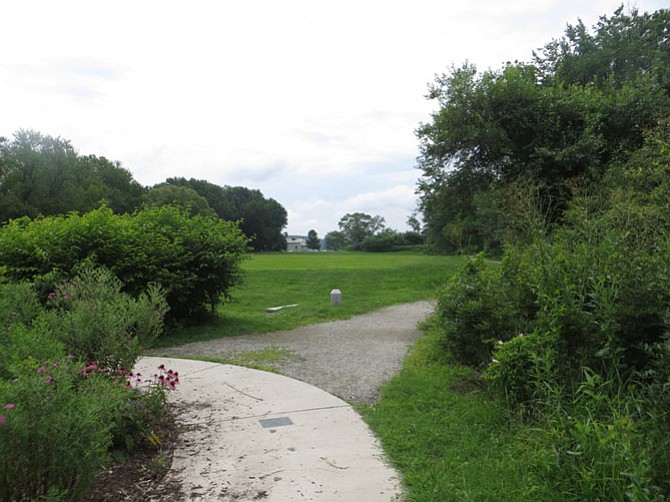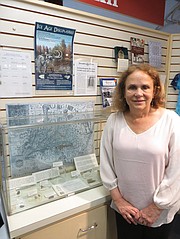Jones Point, where American Indians lived in seasonal camps, fishing and gathering tools from the river.
While many Alexandrians celebrated the city’s 266th birthday on July 11, in truth, residents have lived and commuted here much, much longer. No one at the festival could trace their roots to the first Alexandrians, and little to no written history remains to give detailed accounts of their lives, but historians at the Alexandria Archeology Museum examine flakes of stone tools and broken pottery to piece together what life was like for American Indians living in what is today Alexandria before colonists arrived.
So far, City Archeologist Dr. Francine Bromberg said that while there is no evidence that there was ever a permanent settlement in Alexandria, the area was a major gathering place for temporary fishing and hunting villages. The local American Indians lived and migrated in seasonal patterns. According to Bromberg, American Indian artifacts around Alexandria date as far back as 13,200 years ago.
Much of what is known about American Indians in the area, however, comes from much later. In the early Woodland period, around 1,000 BC, local American Indians would have established extensive campsites along the river close to tributaries. Bromberg said the best evidence for this type of long-term settlement is at Jones Point. Jones Point, at the time, was a peninsula that stuck out into the Potomac and Hunting Creek, and Bromberg said that city archeologists have found fairly extensive evidence of habitation. The American Indians at Jones point were likely exploiting the river’s natural resources and manufacturing tools from cobbles collected along the shore. During surveys before the construction of the Woodrow Wilson Bridge, archeologists discovered flakes in Jones Point from years of quartz and quartzite being chipped away to form tools.
Also at the site, Bromberg said they discovered what she likes to call “Alexandria’s first house.” Archeologists discovered a circular ring of dark stains where saplings had decayed. The home was build around 900 A.D. and Bromberg believes it was a structure made from bent saplings and covered in bark, a fairly common building time for Virginia’s Indians. While the evidence is incomplete, Bromberg also said she believes there was more than one of these in the area. After the tools were made and the local fishing season ended, the tribes that had gathered at Jones Point would split off into smaller family groups and head west to the Piedmont plateau region to hunt.
In other parts of Alexandria, Bromberg said the main activity was likely tool manufacturing. Archeologists discovered a Clovis Point, the city’s oldest artifact, near the Freedman’s Cemetery. The spear point was likely constructed 13,200 years ago. Bromberg said this particular type of point is identifiable by a groove notched into the base of the point to be hafted onto the tip of a spear.
At inland sites, American Indians would bring the cobbles to a hillside and build a fire, to both serve as warmth in the night and to heat the stones, which made flaking easier. Bromberg said a number of these sites have been discovered in Alexandria, particularly in the Stonegate community on the far side of Interstate 395. City archeologists discovered pottery at one of the Stonegate sites, which indicates that American Indians were still living in the area later than the seasonal migrations to and from Jones Point. According to Bromberg, where pottery is discovered, it’s a good chance that local people are staying in the area longer.
According to “Development of a City-State” by Steven Shephard, evidence of American Indian life has been found in the West End near the edges of Hunting Creek and on Shooter’s Hill, the site of the current George Washington Masonic Memorial.
“Alexandria’s first human inhabitants were Native Americans,” said Shepard. “[They] came to the area about 10,000 to 12,000 years ago.”
However, while artifacts have been discovered that date as late as 1600 A.D., Bromberg said there were no true “contact period” American Indian sites found in the area. There was a larger village, called Tauxemont, at Mason Neck to the south and a village located on the grounds of the National Airport. The Doeg tribe lived at Tauxemont, and Alexandria likely would have fallen under their domain, but mostly as hunting and fishing grounds rather than a permanent settlement. The closest Doeg settlement was Assaomeck, or “middle fishing place,” located on the south side of Hunting Creek at the site of the current day Belle Haven neighborhood. Assaomeck and other settlements along the Potomac were identified by John Smith during his 1608 exploration of the region. In 1664, the villagers in Assomeck were pushed south to King George County by the Susquehannocks, who themselves were being pushed south by the Iroquois. In 1714, the tribe moved again to the upper reaches of the Mattaponi River. By 1670, almost 30 years before the first European settlers would arrive in the area, any native living in Alexandria would have dispersed.
However, local archeological understanding of the pre-Colonial history of Alexandria is continually evolving as new artifacts are discovered.
“From my point of view,” said Bromberg, “it’s amazing given all the the development around here that we still have remnants that we can discover.”


